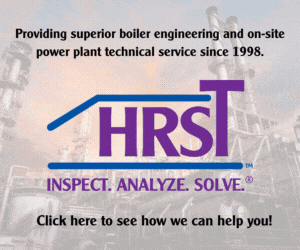How best to replace an HP evaporator: Tubes only or entire harp?
Editor’s note: Online forums hosted by independent users groups are an invaluable communications medium for sharing experiences among industry colleagues. Power Users, which sponsors user-only discussion forums for the groups it manages—7F, Combined Cycle, Generator, and Steam Turbine—most recently launched an online HRSG forum.
It is moderated by former plant manager Bob Anderson. Today a consultant, Anderson is well respected industry-wide for his deep knowledge of heat-recovery steam generators. The HRSG Forum with Bob Anderson, which he chairs, is the leading meeting for boiler users serving at combined-cycle and cogeneration plants powered by gas turbines.
One of the first posts to the new site was from an owner/operator seeking the experiences of colleagues who have replaced the HP evaporators in their HRSGs. What to do? Remove/replace tubes keeping the headers in place, or remove/replace the entire harp. The user said engineers assigned to this project were struggling to decide where the best location might be to draw a line in the HRSG between what should be replaced and what should be retained.
“As we dig deeper,” he said, “we continue to find parts and pieces which could allow advantages to the OEM if we were to just cut the tubes and leave in the existing headers at the top and bottom of the HRSG.”
Another approach, the engineer continued, is to expand the scope of replacement to allow for new headers with connection points defined as the bottom of the steam drum and the feedwater entry. The team’s thinking was that this might provide a more apples-to-apples comparison as opposed to leaving potential proprietary design elements within the HRSG that other companies might not have rights to.
Anderson contributed to the dialog, sharing that he was aware of one module replacement in which the tubes were replaced while the original headers were retained in place. This was not an economic decision, but required because there was no access for cranes to remove/replace the modules. The logistics of the tube replacement were complex and challenging because of limited access and the need to support and maintain alignment of the lower headers.
Anderson figures the total job cost was higher than for a module exchange and certainly required a longer outage. If you replace tubes only, he added, you must either grind off the tube-to-header weld at each end to replace the entire tube (a very time consuming process with risk of damaging the header), or cut the tubes and make a butt weld to the retained portion of the old tube. The $64 question: Can you know that there is no corrosion damage in the retained tube stubs?
Some HRSGs similar to the owner’s Alstom unit, Anderson said, have a primary HP superheater section upstream of the HP evaporator (relative to gas flow). If so, welding in the new tubes only can be accomplished with the welder on the downstream side of the tube. This likely would require mirror welding—a skill becoming harder and harder to find. An alternative might be an orbital welder.
If there’s no HPSH attached to the upstream side of the HP evaporator, a pair of welders could install the first (center) row of new tubes from both sides, but all other rows would require a welder on one side of the tube only. This “welding your way out” technique means that any leaks deeper than the row accessible from the maintenance bay will require removal/replacement of some good tubes—perhaps many—to access and repair the failure. Anderson estimated the HRSG under discussion has more than 1150 HP evaporator tubes. That’s 2300 welds made from one side that must be perfect.
All other HP evaporator replacements Anderson is aware of relied on replacement harps or entire modules. They were removed/replaced during a much shorter outage than required for the tube-only replacement. Minimizing the number of field welds reduces outage duration and facilitates control over component fit-up, weld quality, NDE inspection, and hydro/repair—if needed. Plus all of these tasks remain outside the outage critical path.
Modules have been removed/replaced by lifting upward out of the HRSG the way they were originally installed (often requiring removal of the HP drum for access), or removal through the side of the HRSG to avoid disturbing the drum. The location of the HRSG side support columns will dictate if the new module can be removed/replaced in one piece or not.
Anderson continued, “If your unit has the two large-diameter fore and aft collection manifolds between the headers and the drum like other HRSGs from this OEM, you have a couple of choices on where to make the upper transition. The tradeoff will be the cost of material replaced versus the number of field welds required. The location of the HRSG’s side support columns may dictate that the second option is possible only if the column permits removing the entire evaporator module intact.
Finally, Anderson recommended against the tube-only replacement option on this project. He suggested asking the bidders to identify and quote their preferred cut points top and bottom (save the collection manifolds and have more internal field welds, or replace the fore-aft manifolds and have no internal field welds and only a few external field welds), plus insist the bidders quote an option for the alternative cut-points they do not prefer.






